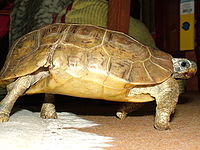
Photo from wikipedia
BackgroundTortoises (Testudinidae) occur in a wide range of environments, providing important ecosystem functions, such as seed dispersal and refuge in the form of burrows. Tortoise movement has previously been shown… Click to show full abstract
BackgroundTortoises (Testudinidae) occur in a wide range of environments, providing important ecosystem functions, such as seed dispersal and refuge in the form of burrows. Tortoise movement has previously been shown to be related to resource availability, reproductive status and local environmental conditions. However, understanding of the variables that drive their movement remains comparatively low. We investigated aspects of movement in leopard tortoises Stigmochelys pardalis—the largest and most abundant tortoise species in sub-Saharan Africa—in response to environmental, climatic and individual variables in the semi-arid Karoo, South Africa. We used GPS telemetry to calculate bihourly and daily movement and used generalized linear mixed models (GLMMs) to ascertain important predictor variables.ResultsTemperature, distance from water sources, and month were important variables for predicting both bihourly and daily movement. Our results showed that movement increased when individuals were close to known water sources, indicating that individuals close to water resources make regular long distance movements. Movement showed a positive relationship for temperature in both models, whilst rainfall was an important predictor for bihourly movement. Our results displayed aspects of seasonality, with movement highest in spring months, likely related to reproductive activities, although no sex differences were observed.ConclusionsWe identified temporal and spatial conditions in which leopard tortoise movement increased. Our results further support the relationship between water as a resource and movement in leopard tortoises. Individuals used one of two basic movement behaviours in relation to water in this water scarce environment. Either an individual’s home range and movements included permanent water resources allowing internal water storage replenishment, or excluded these with reliance on food resources (such as grasses, forbs, and succulents) for water.
Journal Title: Movement Ecology
Year Published: 2017
Link to full text (if available)
Share on Social Media: Sign Up to like & get
recommendations!